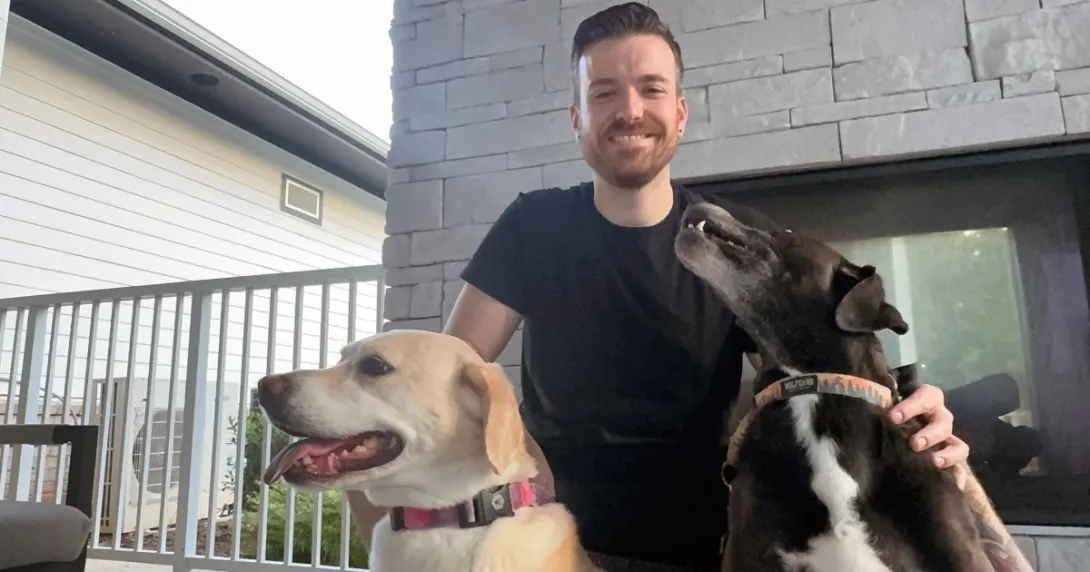
Lotus (left) and Bane (right) with their best friend Ross Rigdon, COO at Raleigh Orthopaedic
Photo: Ross Rigdon
Raleigh Orthopaedic is one of North Carolina's largest independent orthopedic practices with 54 providers and six locations across the state. It has been specializing in musculoskeletal care for more than 100 years.
THE CHALLENGE
Managing the daily call volume for such a large footprint – which spans busy clinics, surgery centers and therapy facilities – became increasingly difficult in the face of staffing shortages and rising patient demand.
"One of the hardest things in a healthcare call center is staffing for Mondays versus Fridays," said Ross Rigdon, COO of Raleigh Orthopaedic. "Call volumes are not consistent throughout the week. People often wait until Monday to call after weekend injuries or illnesses, which can mean ten times more calls than on a Friday, when we may only need a third of that staff.
"And finding qualified staff always is a challenge, particularly in healthcare," he added.
PROPOSAL
To address these challenges, Raleigh Orthopaedic turned to vendor Relatient to help streamline patient access and reduce the strain on scheduling teams through the company's Dash Voice AI. Powered by agentic AI, this conversational voice AI feature is part of the vendor's Dash Schedule platform.
"Anytime we evaluate a vendor, we focus on three key things: Are they addressing a real need? Can they actually solve the problem? And is their customer service responsive?" Rigdon explained. "Relatient checked all the boxes and tackled our biggest challenges, which were call abandonment and uneven staffing.
"With agentic AI handling repetitive, simpler tasks, we can staff more evenly across the week," he continued. "Patients already are accustomed to digital self-service, whether booking flights or shopping online, so healthcare needed to catch up. Now with AI, they can schedule appointments outside business hours, even at 11 p.m. when their back hurts from playing with their kids. That spreads demand more evenly across the week."
AI fills the gaps by taking over tasks like confirming appointments, providing directions or routing calls, he added.
"This allows us to expand our hiring pool and prioritize customer service skills, which are harder to teach than medical terminology or knowledge," he noted. "Entry-level employees then can naturally transition to more advanced roles while AI helps backfill basic responsibilities. Instead of patients waiting on hold to get transferred, the AI agent helps patients get what they need done quickly, freeing our staff to focus on more complex patient needs."
MEETING THE CHALLENGE
The agentic AI in Raleigh Orthopaedic's call center now handles all incoming calls. It routes calls to billing, administrative assistants or wherever they need to go. Scheduling remains the staff's primary focus, while the AI directs callers efficiently to reduce hold times. Patients also interact directly with the AI through the self-scheduling platform.
"The platform integrates directly with our EHR, pushing and pulling patient demographics, chart numbers and insurance data," Rigdon explained. "This feeds into our scheduling software within the EHR itself. We have an on-premises server-based EHR, and a lot of other vendors can either push or pull data.
"They can't push and pull," he continued. "Typically, they can only push the information into us, which creates bottlenecks. With Relatient, it flows both ways, so we can work directly in the scheduling platform and without toggling into the EHR. We're confident the information is entered accurately into the patient's chart."
Even with an outdated phone system, the agentic AI system integrated smoothly, he added. And the system's ability to adapt to the provider's "notoriously difficult EHR" has been impressive, he said.
RESULTS
More than half of inbound calls (54%) are answered by AI, and 38% are handled completely by AI. The provider organization receives 1,100 calls in a single day – hundreds now never need staff intervention. This reduces staffing needs at a huge cost savings as employees shift to higher-touch responsibilities.
"The patient experience has improved as well," Rigdon reported. "Patient time on the phone has decreased to four minutes or less, and the call abandonment rate has decreased eight points within weeks of deployment. With AI taking over basic, transactional calls, patients aren't waiting on hold or being transferred multiple times. They're routed directly or have their needs met without staff intervention.
"Put together – reduced call times, fewer abandoned calls, less need to hire and train staff for entry-level roles, and redeployment into more complex work – the value is undeniable," he continued. "The AI isn't just a convenience, it's reshaping call center operations to be more efficient, cost-effective and patient-friendly."
Rigdon is confident in the AI's capabilities, but he said it's reassuring to see the numbers match expectations. Too often vendors promise more than they deliver – in this case, the provider is getting exactly what it paid for, he added.
ADVICE FOR OTHERS
Work with a vendor that listens, understands challenges and integrates its systems directly with existing systems, Rigdon advised.
"Downtime matters – even two minutes can create significant delays – so always ask for outage reports and uptime metrics," he said. "Implementation is equally important. Clean data is essential, and the results you get depend on the effort you put in.
"Provide feedback and let the vendor adapt the product," he concluded. "They often see patterns across multiple organizations that you wouldn't notice. Work with companies that want to collaborate, not just sell. Look for those that listen, adapt and deliver systems that actually work."
Follow Bill's health IT coverage on LinkedIn: Bill Siwicki
Email him: bsiwicki@himss.org
Healthcare IT News is a HIMSS Media publication.
WATCH NOW: How can an IT exec become a Chief AI Officer – and then work with the C-suite


